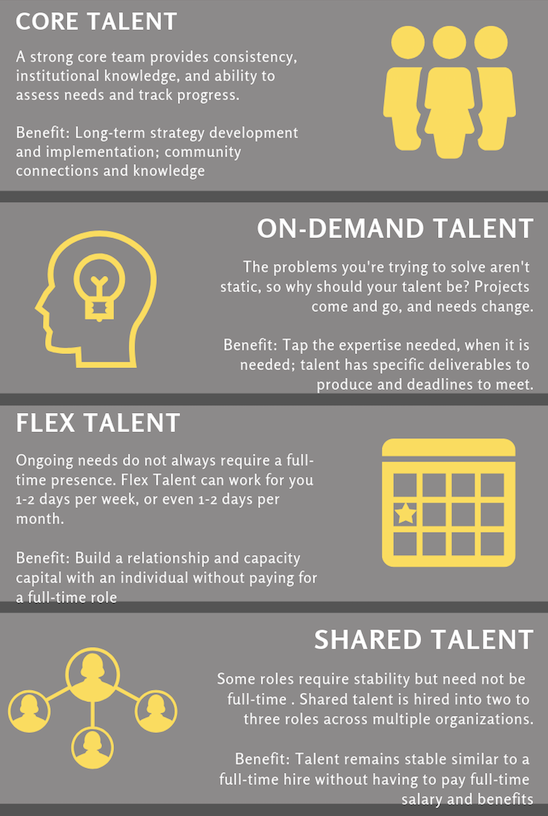|
The Challenge Nonprofit organizations face a paradox: they are expected to tackle our nation’s biggest challenges, yet 62% of Americans believe they spend too much on infrastructure. Despite this public perception, organizations rarely have adequate resources to achieve their missions. And while some philanthropic groups are starting to adopt a pay-what-it-takes approach to funding, there are finite private and public dollars to solve an ever-changing array of social challenges. When nonprofits fail to achieve goals, it’s common to blame programmatic shortfalls or, worse, the service recipients themselves, when in fact many projects are doomed from the start with inadequate resources to achieve results and scale them. Whereas for-profit companies receive millions of investment dollars, often running at a deficit for years while perfecting their products, nonprofits are expected to see immediate results. Emerging Opportunities New workforce trends present opportunities for nonprofits to do more with the same (or less), trends that the corporate sector has already been quick to embrace. The first is the emergence of the so-called gig economy, or the prevalence of contract-based, project-driven work and freelancers who work on-demand for hire. There are 58 million freelancers in the U.S. today, with over half of the American workforce expected to freelance within the next decade. A related trend is workers’ desire for flexibility; 96% of the workforce wants or needs workplace flexibility yet only 19% have access to a range of flexible options. Among workers surveyed, 78% preferred remote work, 74% preferred the ability to shift their schedules, and nearly half sought stable, high-level part-time work. These trends suggest on-demand talent is not only available, but that more and more seasoned leaders and experts are actively seeking flexible work arrangements that can yield both quality and fiscal benefits for organizations. New Talent Models for the Nonprofit Sector I believe on-demand and talent-share models can radically change how nonprofits do their work, increasing the resources available to design and expand effective programs and services. Frequently thought of as “agile talent” in the corporate sector, companies use on-demand services to test ideas, quickly launch solutions in the face of unexpected challenges, and pull in brainpower as it’s needed.
Not only is this a smarter way to get to results, but it’s a money saver, too. The average New York nonprofit spends $60,000 on a grant writer, $70,000 on a staff accountant, $80,000 on a communications specialist, and $100,000 on a human resources lead, with typical benefits packages costing 15%-30% of salary. In addition to these costs, employees require equipment, supplies, space, and supervision. Moreover, research suggests employees are only productive for 3-5 hours/day, suggesting organizations pay for many staff hours each day that do not contribute to supporting your mission.
A nonprofit that replaces just one role with comparable on-demand support can conservatively save $20,000 to $80,000 per year depending on the role. When translating this into results, savings from one role change can translate to 16,000 additional meals to serve the homeless, 5,600 more days of after-school programming for children, or 230 more days of job training for young adults. An exploratory survey of nonprofit leaders suggests they are more open to using on-demand talent than ever before, with 68% using consultants to fill gaps in expertise, 63% filling an entire function with consultants (e.g., grant writing, fiscal management), and 43% replacing one or more full-time roles with consultants. Survey respondents noted that using consultants helps keep costs low, but that it can be difficult to explain their talent model to stakeholders who are accustomed to traditional staffing models. Balancing Opportunity with Pragmatism (and Equity) This framework does not advocate that we broadly terminate staff and only use consultants, and certainly does not suggest we stop investing in benefits typically tied to employment for our talent. Here are a few underpinning ideas for this new talent model to work for both organizations and individuals.
Looking Ahead Change Impact is currently implementing these talent models with a small group of nonprofit partners and plans to launch a number of services to help nonprofits leverage talent in new ways. To learn more about partnering with us, or to sign up for news on this topic, please reach out at [email protected]. Change Impact is a consortium of consultants with extensive and specialized experience in the social sector, led by Jen Siaca Curry, Ed.D. Change Impact is a NYS- and NYC-certified minority and woman owned business. Thanks to Lucy Friedman, Caleb Jonas, and Danielle DiMare for contributing feedback on this article prior to publication. Header photo credit: The Iconfinder Blog Comments are closed.
|
Archives
January 2019
Categories |



 RSS Feed
RSS Feed